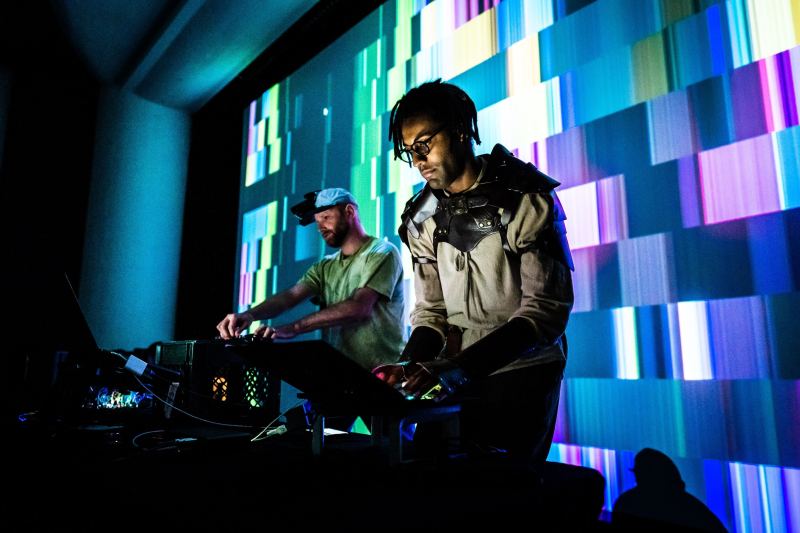I never thought I’d be caught in the middle of an argument about coding languages at an EDM concert, but there I was.
The room full of musical nerds quietly bobbing their heads to glitchy electronic music was an algorithmic dance party called “Hexcode: a Halloween Algorave,” held on Thursday at Gray Area in San Francisco.
These live coding shows have been around for just over a decade, according to the official “Algorave” website. Algorave, a portmanteau of “algorithm” and “rave,” is defined as “sounds wholly or predominantly characterized by the emission of a succession of repetitive conditionals.“ The performances usually consist of one or more performers onstage with computers using specialized coding languages to create live music, sometimes accompanied by visuals. These shows allow musicians and computer scientists to live at the intersection of music and code.
There was something magical in the free-flowing improvisatory nature of the performances, the true excitement of a surprised crowd and the attitude of counter-culture that seeped its way through the whole experience. Coming from a strong humanities background, my grasp on the more “CS” aspects of the event was a bit limited, but I truly did enjoy the way it made me feel.
The music had an unpredictability about it, like there was probability involved. It wasn’t like watching a rom-com where you knew exactly what was about to happen; it was more like an M. Night Shyamalan movie. There was no way to know what note was going to play next, and the amazing thing is most of the musicians also had no idea.
“That’s gotta be Python,” one Luigi-masked man said of the code on screen.
“No, it’s definitely JavaScript,” said a woman dressed as a bottle of Fanta.
The theater was pulsating with a crowd of costumed revelers (it was a Halloween party, after all) as well as the jittery bounce of Sideb0ard x Sideb0ard, a duo of silver-clad artists creating music and generative art with code right there on the spot. Behind the two artists was a screen with psychedelic visuals in full datamosh mode; to our right was another screen onto which the musical code was being projected.
The event was hosted by AV Club, a Bay Area-based algorave collective focused on promoting algorithmic music in the Bay. The event was co-organized by Dan Gorelick, Rodney Folz and R. Tyler McLaughlin, a computational biologist by day, algoraver by night. What the “R” stands for is a secret.
“I have been playing music my whole life,” said McLaughlin. But when he moved to Texas for his Ph.D., he found himself searching for music in different ways: he started applying machine learning to music theory, creating new rhythms and posting them to social media. His friend Danielle was also posting about algorithmic music at the time, so he got in touch.
“I knew that it was something I was gonna spend some time with because it was so, so different and quantitative and not just math and nerdy.”
There were nine pairs of artists who performed throughout the night, each composed of one “visualist” and one musician. Most were paired by AV Club: “There are at least 10 people who do performances with AV Club, and if two people haven’t played together for a long time or ever, we’ll try to put them together,” McLaughlin said.
The nine sets of the night included Dan Gorelick with Andy Rolfes — who performed with a joystick-controlled bird flying on the screen — and Celeste Betancur with Olivia Jack, who launched their set with code spelling out “//hi everyone :].”
Thorsten Sideb0ard, one of the music-makers in Sideb0ard x Sideb0ard, told me that his inspirations were simple: “energy and originalism.” The musician invented the live coding environment Soundboard, which he was using to make his music.
“I am drawn to algorithmic music because of the idea that there is a freely evolving beauty in the music, which appears at the release of artistic control,” said Lara Arikan ’23, who teaches ITALIC 99: An Introduction to Algorithmic Composition.
As a jazz musician, my go-to way of contextualizing the event was thinking of it as just another form of improvisatory music. I’ve struggled with the question of defining the borders of what even defines jazz, so it was comforting to hear a masked man (who later identified himself as just “Tam”) say, “this is jazz, in a way.”
“I really want to give people a sort of experience that is similar to when jazz was first coming out and all these new chords and rhythms were being played and people didn’t really know what to think at first,” McLaughlin said.
“Do you understand what’s going on?” Tam asked me later in the night, to which I promptly responded, “No, but I love it!”
Editor’s Note: This article is a review and includes subjective thoughts, opinions and critiques.
